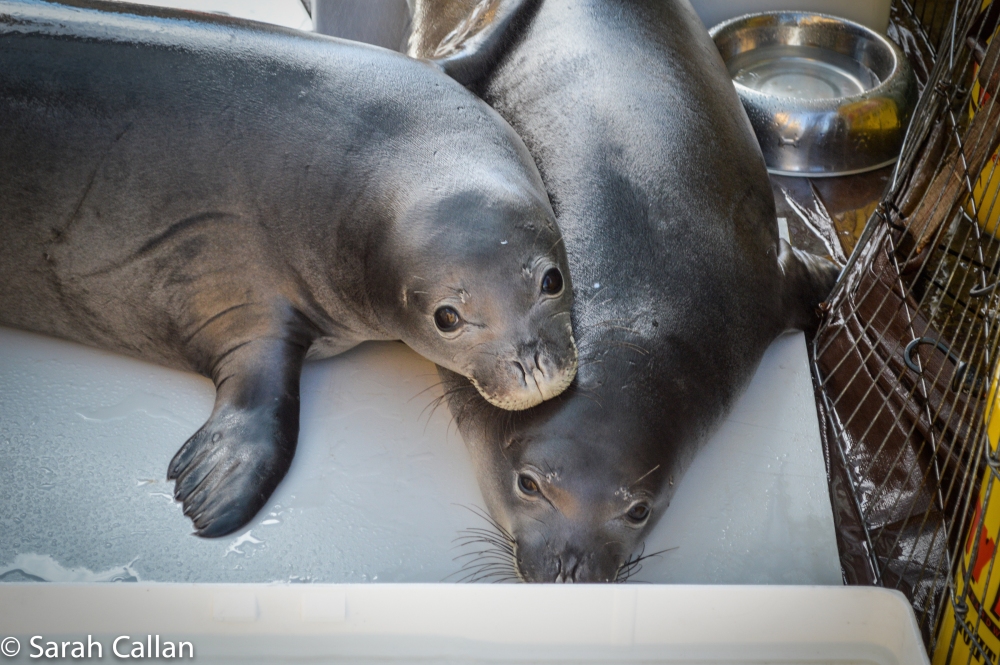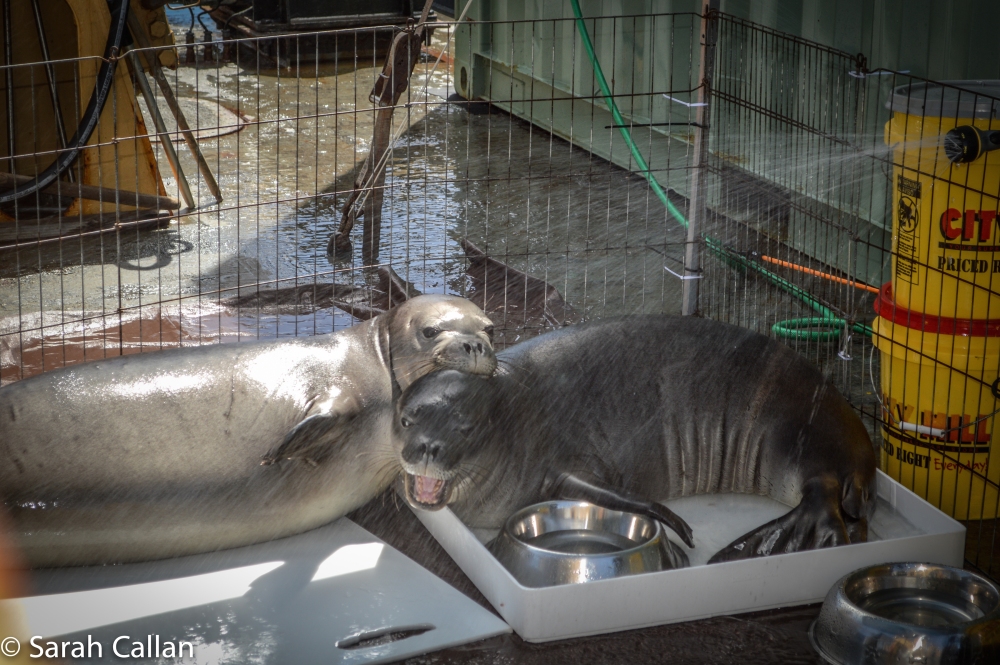It looked like someone had spilled a bottle of glitter on the sky last night. That’s how many stars were twinkling when I stepped onto the aft deck for my “seal watch.”
The Northwestern Hawaiian Islands lay in a curved line on a map. You’d think our route would start with the nearest—Nihoa—and follow in order moving northwest one after the other. But life doesn’t always work in an orderly way, and our research cruise has taken a bit of a circuitous route, too.
We originally left Honolulu on September 6 and made our first stop at Ni`ihau. Then, we hopscotched to French Frigate Shoals and dropped off some crew. From there, we circled back to Honolulu to pick up more crew and two very special passengers: Pearl and Hermes.

These two Hawaiian monk seals were born in late April or early May and had already been weaned when summer field campers with the NOAA Fisheries Hawaiian Monk Seal Research Program arrived at Pearl and Hermes Reef a few weeks later. For some reason we don’t know, the two pups had been weaned young, meaning they didn’t get the full benefit of fattening up on their mother’s milk for the typical four to six weeks. So, they were underweight. The female, who was named Pearl, weighed 33.5 kilograms. The male, named Hermes, weighed 40 kilograms. At these weights, their long-term survival was deemed highly improbable.
Hawaiian monk seals are critically endangered. With fewer than 1,100 individuals across the Main Hawaiian Islands and Northwestern Hawaiian Islands combined—an archipelago that stretches 1,500 miles across the Pacific Ocean—the team trying to save the species has adopted a proactive response to situations such as Pearl’s and Hermes’. They are not taking a wait-and-see approach to malnourished, sick, or injured monk seals. More than 30% of the Hawaiian monk seal population is alive today, because of proactive intervention by these scientists.
Last summer, a medical facility known as Ke Kai Ola opened in Kona on Big Island. Staffed with skilled technicians from The Marine Mammal Center out of Sausalito, California, Ke Kai Ola specializes in rehabilitating injured and emaciated Hawaiian monk seals.
When Pearl and Hermes were found, the Hawaiian Monk Seal Research Program scooped them up and transported them back to the Main Hawaiian Islands and Ke Kai Ola. Now, we are returning them to their natal beaches.
During the past four months, the weaners have packed on the pounds. At their last weigh in before boarding the ship, Pearl weighed 61.5 kilograms and Hermes 72 kilograms. That’s closer to the weights of weaned Hawaiian monk seal pups that we see in the Main Hawaiian Islands.
Twice a day, on the ship, they slurp up 1.5 to 2 kilograms of fish. That’s a bucket of fish for each. They’re also at that age when they put anything and everything in their mouths. That bungee cord holding their portable pen in place? That fold in the tarp on the ship’s deck? That “fishcicle” slipped into their pen to entertain them between meals? It all goes in their mouths. Or, at least, they try to mouth everything. The best, though, is the water hose. They love sticking their faces in the mist of water spraying from the nozzle. That is, when they’re not stealing fish out of the other one’s mouth.

Thankfully, when my watch started at 2:30 a.m. last night, in the dark of the new moon, they were sleeping. Mostly.
Every time I would start to nod off, one of the two would sneeze. Loudly. At a decibel level that would make me jump out of my chair. Then, one—I suspect it was Hermes, because he’s got a reputation for it—must have processed his recent meal of two kilograms of fish, because an odorous wave of something less than pleasant nearly washed me overboard. When I say, “stinkin’ seals,” I’m not just referring to their charismatic faces with big, round, doe eyes. Yes, they are stinkin’ cute, but they can also produce a real stink. Some would call it impressive.
In a few days, we’ll release the plumped-up Pearl and Hermes at their natal beach, knowing we’ve done just about everything we can to give them a leg up on their competition–the big fish of the sea–and boost their chances to live a good, long life of 25 to 30 years. They’ll go from emaciated to emancipated.

Oh so stinking funny. I’m headed tomorrow to Toronto Canada to see DianeTilley and perhaps view a Grey Wolf sanctuary…..you can’t have all the fun
With fond aloha………Nicki
LikeLike
I’ll expect nice, long, blog reports, Nicki!
LikeLike
What a wonderful report! I’m looking forward to hearing how they take to freedom.
LikeLike
We’ll be tagging them with GPS devices, so we’ll be able to tell where they go;-)
LikeLike
Watching their return will be a serious highlight. How long is the journey? In time please, not nautical miles.
LikeLike
Pearl’s and Hermes’ journey will last another 25 to 30 years, hopefully! All total mine aboard the ship is 28 days!
LikeLike
Keep the reports coming. I was wondering if you went back to Oahu, now confirmed.
LikeLike
Confirmed.
LikeLike
Do they play with the hose when you try to clean the stinking cute mess?
LikeLike
They try to play with the hose ALL the time. Sticking their faces directly in it is the absolute best, apparently!
LikeLike
What a GREAT life adventure you’re on! I am so enjoying the journey, and am so glad that you’re allowing us to hitch a ride…. I really enjoyed this story. 🙂
LikeLike
Thanks, Sue. It’s hard not to like Pearl and Hermes!
LikeLike
Let’s give a shout out to the local highly trained and experienced volunteers who staff the hospital under the supervision of Deb Wickham. Most of the hands on work with the seals comes from a team on Hawaii Island that has been working with monk seals in the field as response team members for years. With training received by some at TMMC and under the leadership of Deb these volunteers deserve a lot of credit too. It’s not just TMMC personnel from California, it’s a team effort that needs dedicated local volunteers.
LikeLike
For sure. Volunteers are an integral part to the Hawaiian Monk Seal Research Program.
LikeLike
F-ing hilarious Kimmy. What a fun read. I swear I smell something…. could it be my own feet. I don’t know…. Could be your description.
More.
LikeLike
Thanks, Pammy. It is truly a smell like no other!
LikeLike
Oops! I meant from Honolulu to Pearl and Hermes 🙂
LikeLike
Ah, good question, Mary: 1,200 miles. We’re getting close now. I’m going to miss those stinkers.
LikeLike
Bless you, Hermes! And Pearl too. All of the senses are engaged here at sea! 🙂
LikeLike